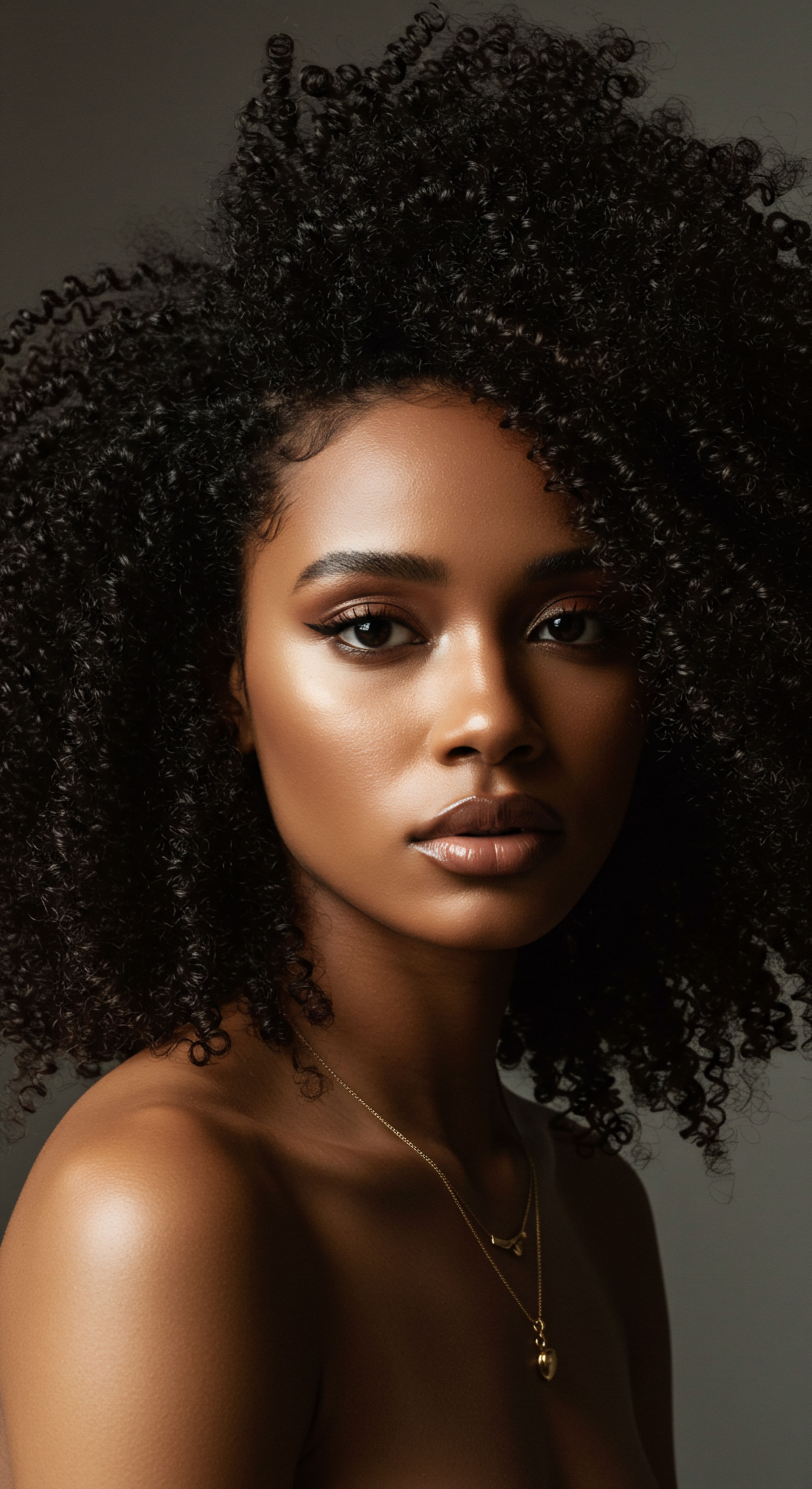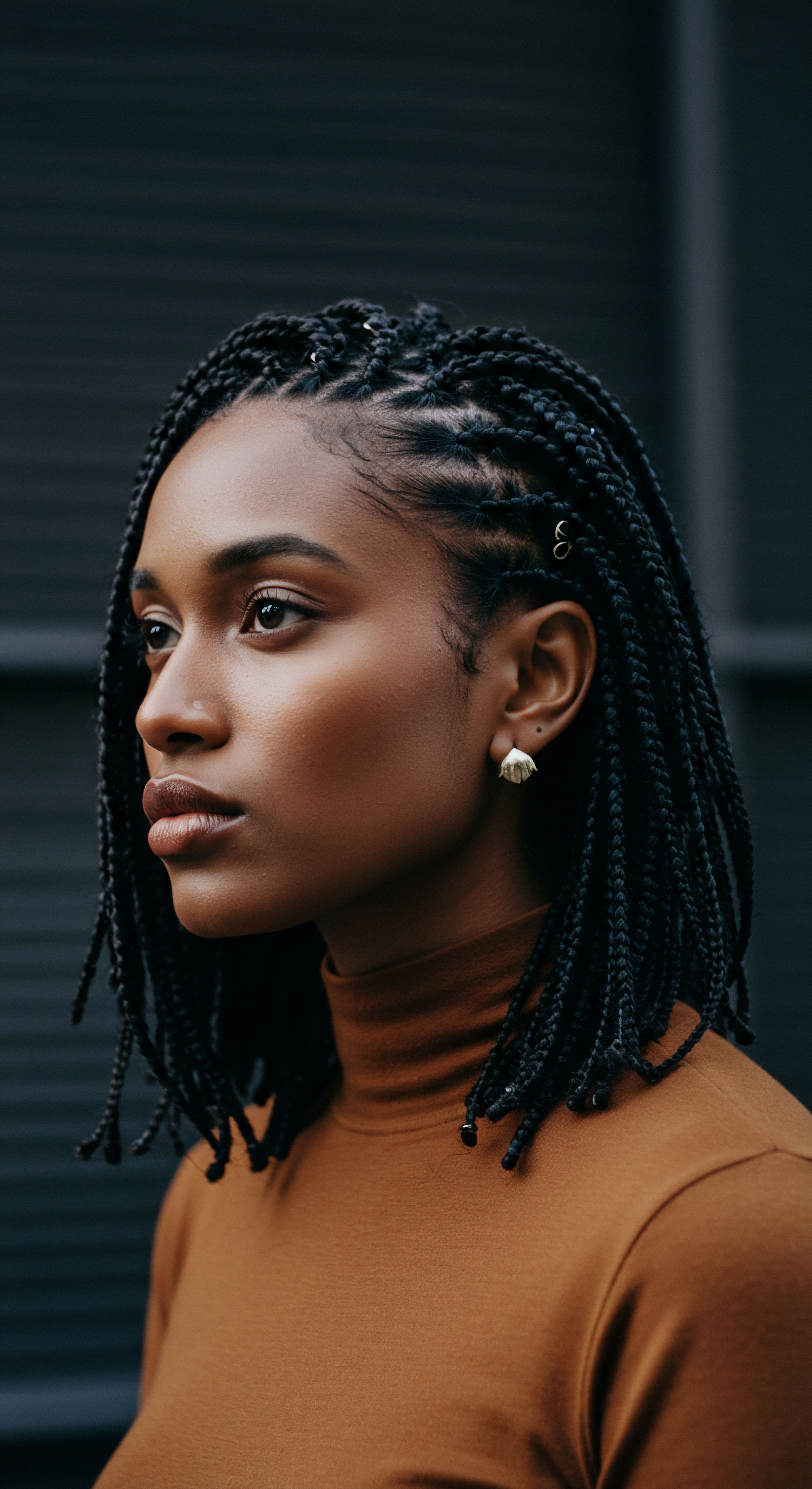
Roots
Consider for a moment the profound connection we hold with our hair, a silent storyteller of identity, heritage, and care. Even today, it speaks volumes without a single word. Now, cast your thoughts back to ancient Egypt, a civilization whose meticulous approach to presentation often leaves us in quiet wonder. Here, hair, or its artful substitute, the wig, held a similar, deeply resonant significance.
Far from a simple adornment, these hairpieces were a visible declaration, a carefully chosen expression within a society defined by strict social structures. To truly understand the influence of social standing on ancient Egyptian wig styles, we must first look to the foundational understanding of hair itself, and how its inherent qualities shaped human interaction with it across time.
The dry climate of Egypt played a significant role in preserving not only human remains but also hair and wigs, granting us a rare window into these ancient practices. Scholars have, for centuries, poured over tomb paintings, statues, and the physical artifacts themselves, piecing together a chronology of hair practices from the Predynastic period through the Ptolemaic era. These studies reveal a culture where hair, whether natural or artificial, was never merely an afterthought. It was a canvas, a shield, and a marker, all at once.

What Did Hair Mean to Ancient Egyptians?
In ancient Egyptian society, hair was far more than a biological outgrowth; it was an embodiment of personal identity and social position. It could convey religious undertones, signal erotic potential, and display information about one’s gender, age, and social status. This understanding forms the groundwork for comprehending why wigs gained such prominence.
- Hair served as a marker of identity, conveying gender, age, and social status in ancient Egypt.
- Personal Hygiene was a key consideration, with wigs providing protection from lice and sun.
- Religious and Ritualistic significance was also present, particularly for priests who shaved their heads for purity.
The very decision to wear a wig, or to keep one’s natural hair, was a deliberate act, steeped in cultural norms and practical considerations. The intense heat of the Nile Valley, for instance, made shaved or closely cropped natural hair a practical choice for many, offering comfort and helping to deter lice. Wigs then provided a means to cover these shaven heads, offering both sun protection and a vehicle for elaborate display. This dual purpose, combining hygiene with aesthetic desire, laid the foundation for wigs becoming an indispensable element of ancient Egyptian attire.
Ancient Egyptian wigs were not merely fashion statements; they served practical purposes of hygiene and sun protection while acting as clear indicators of social standing.
The early examples of hair adornment, dating back to around 3900 BCE, include decorative combs made of ivory, often featuring animal motifs. These early accessories hint at an existing culture of hair styling and personal adornment long before wigs became widespread. The appearance of hair extensions as early as 3400 BCE in a female burial at Hierakonpolis suggests a long history of augmenting natural hair, paving the way for the development of full wigs.
The materials used in wig construction also speak to a fundamental understanding of resources and their perceived value. While the finest wigs were crafted from human hair, more accessible versions incorporated plant fibers, wool, or even horsehair. This variation in material points to an early stratification, where the quality of the wig directly correlated with the wearer’s ability to procure expensive raw materials. The intricate processes involved in cleaning, separating, and preparing hair for wigmaking, along with the skill required to braid hundreds of individual plaits onto a mesh cap, suggest a specialized craft that would naturally be costly.
Even the depiction of hair in art provides a wealth of information. Art historians like Gay Robins have analyzed tomb chapels, which were commissioned by high-ranking male officials, to discern how hair and wigs reflected gender, status, and age. These idealized portrayals show that elite men often wore wigs above shoulder level, with the most distinguished styles featuring elaborate curls or braids.
Their sons, holding a junior rank, were often depicted with shorter, round wigs or shaven heads. This artistic representation underscores the societal understanding that hair styles were indeed a visual language, communicating one’s position within the intricate social framework.

Ritual
Stepping from the foundational understanding of hair’s role, we now consider the daily and ceremonial practices that shaped the ancient Egyptian wig experience. How did these elaborate hairpieces move from concept to creation, and how did their practical application mirror the strict social stratification of the time? The creation and wearing of wigs were not spontaneous acts; they were rituals, steeped in purpose and governed by unspoken rules of decorum and social display. This section peels back the layers of these practices, revealing the artistry and the underlying social directives that guided their use.

How Were Wigs Crafted and Maintained?
The creation of an ancient Egyptian wig was a testament to skilled craftsmanship and resourcefulness. Wigmakers, a respected profession, would collect human hair, often obtained through bartering or purchase, valuing it akin to gold in some accounts. This raw material would then undergo a meticulous process of cleaning to eliminate lice eggs, followed by separation into hundreds of individual lengths. Each length, containing approximately 400 hairs, would be coated with a warmed mixture of beeswax and resin, which served as a fixative, holding the strands together and allowing for precise styling.
The prepared hair was then artfully attached to a mesh cap, often made of fine netting, sometimes itself composed of hair. This labor-intensive process resulted in durable pieces, many of which have survived to this day, offering tangible proof of their quality and the belief that they were essential for the afterlife.
The construction of ancient Egyptian wigs was a labor-intensive craft, involving human hair, natural resins, and meticulous artistry, reflecting the high value placed on these items.
Wig styles varied significantly across different periods of ancient Egyptian history, yet each period saw certain styles associated with specific social echelons. During the Old and Middle Kingdoms, shorter, simpler styles prevailed, with some featuring overlapping curls or bangs that framed the face. As the New Kingdom dawned, wigs grew larger and more elaborate, often incorporating long, tassel-ended tails, beads, ribbons, and caps. Men often favored less bulky wigs, sometimes longer in the front.
Beyond daily wear, special occasions and religious ceremonies called for the most expensive and ornate wigs, highlighting their role in public and ritualistic display. The practice of wearing beard wigs, for instance, became a powerful symbol of pharaonic authority, signifying a living god on earth. Even queens, such as Hatshepsut, adopted these ceremonial beard wigs.

Who Wore Wigs and Why?
The wearing of wigs in ancient Egypt was not universal. While both men and women of the elite classes donned them, their use was strictly regulated by social standing.
| Social Group Elite Men and Women |
| Wig Usage Predominantly wore wigs daily and for special occasions. |
| Associated Styles / Materials Finest human hair, elaborate curls, braids, double-decker styles, gold adornments. |
| Social Group Middle Class |
| Wig Usage Wore blended wigs or those made from less expensive materials. |
| Associated Styles / Materials Part human hair, part vegetable fibers, or sheep's wool. |
| Social Group Priests |
| Wig Usage Generally shaved their heads for ritual purity, did not wear wigs daily. |
| Associated Styles / Materials May have worn specific ceremonial wigs (e.g. side-locks for ritual roles). |
| Social Group Children |
| Wig Usage Did not wear full wigs; often had shaved heads with a side-lock. |
| Associated Styles / Materials Natural hair styles for youth. |
| Social Group Slaves and Servants |
| Wig Usage Prohibited by law from wearing wigs or shaving their heads. |
| Associated Styles / Materials Natural hair, often short or shaven, indicating subservient status. |
| Social Group The material, complexity, and sheer presence of a wig clearly communicated one's social standing. |
The practical aspects of wig wearing extended beyond mere aesthetics. Wigs provided shade from the intense Egyptian sun, a crucial function given the often-shaved or closely cropped natural hair beneath. They also offered a defense against lice, a persistent concern in ancient times, contributing to overall hygiene.
However, the primary drive for their adoption by the elite was their symbolic value. A wig signaled high rank, wealth, and a commitment to the prevailing standards of beauty and cleanliness.
The ability to commission and maintain multiple wigs for different occasions further underscored one’s prosperity and social standing. The shift in styles across dynasties, from the simpler forms of the Old Kingdom to the voluminous creations of the New Kingdom, suggests an evolving language of status, constantly redefined through sartorial choices. The visual evidence from tomb paintings and reliefs consistently depicts the elite with their elaborate wigs, a clear indicator of their privileged position within society.

Relay
As we move beyond the practicalities and daily customs, a deeper inquiry into ancient Egyptian wig styles and their societal resonance reveals a profound interplay of cultural, economic, and even psychological factors. How did these hairpieces not only reflect social stratification but actively participate in its reinforcement, becoming tangible symbols of power and identity? This section ventures into the more complex, interconnected dimensions of this relationship, drawing upon scholarly insights and archaeological data to illuminate the nuanced dynamics at play.

Did Wig Cost Reflect Social Standing?
The economic investment required for ancient Egyptian wigs provides a compelling lens through which to observe social hierarchy. Wigs were indeed costly items, with their price directly tied to the materials used and the labor involved in their creation. The most prized wigs, crafted entirely from human hair, were exceptionally expensive. Accounts from the town of Kahun, for instance, listed hair’s value in the same category as gold, underscoring its scarcity and desirability.
For the middle class, a compromise was often found in blended wigs, combining human hair with vegetable fibers or sheep’s wool. The most economical versions were made solely from plant fibers. This material differentiation alone served as a clear, visible marker of economic standing.
Consider the meticulous process ❉ collecting human hair, cleaning it, separating it into hundreds of individual lengths, and then painstakingly attaching these to a mesh cap with beeswax and resin. This was not a task for the unskilled or the quickly produced. The time, expertise, and raw materials required meant that a high-quality wig represented a significant expenditure.
The economic cost of ancient Egyptian wigs, particularly those made from human hair, served as a direct and undeniable indicator of wealth and social status.
A compelling case study on the economic value of wigs comes from a reconstruction of a wig’s cost in ancient Egypt. According to a study, a wig could cost as much as 2 deben of silver, or 180 grams of refined silver. To contextualize this, a male weaver’s contemporary salary was approximately 19 drachmas and 4 obols per month. This means that purchasing such a wig would require about two months and three weeks of a weaver’s salary.
This striking figure vividly illustrates that only the truly affluent could afford such an item, placing it far beyond the reach of the common laborer. This expenditure was not merely for vanity; it was an investment in a symbol that publicly affirmed one’s position within the societal pyramid.
This economic barrier effectively restricted complete wigs to the elite, transforming them into powerful visual cues of high social rank. The very presence of an elaborate, human-hair wig on an individual signaled not only their personal wealth but also their access to skilled labor and precious resources, reinforcing the existing social order.

How Did Wig Styles Reinforce Social Boundaries?
Beyond the raw cost, the styles themselves acted as a codified language of social distinction. Art historical analysis, particularly by scholars like Gay Robins, highlights how depictions in tomb chapels—commissioned by high-ranking officials—deliberately showcased social stratification through hair.
- Elite Adult Men wore wigs above shoulder level, often intricately styled with curls or braids, signifying their elevated position.
- Sons of Elite Men, holding a junior rank, were typically shown with shorter, round wigs or shaven heads, visibly marking their subservient status within the family and broader society.
- Priests and Household Servants were frequently depicted with shaven heads, symbolizing their subservient status to a deity or master.
- Elite Women and Female Household Servants were distinguished by long hair, often falling below the shoulders, reinforcing their gendered roles tied to fertility.
This visual taxonomy meant that one could discern an individual’s place in the hierarchy simply by observing their wig or hairstyle. The ability of elite men to wear wigs made from the hair of other people underscored their power to command resources and labor for their own purposes, a stark display of dominance.
The evolution of wig styles also mirrored societal changes. The institutionalized canon for hairstyles that emerged at the end of the Old Kingdom, coinciding with a stronger central administration, solidified the role of hair as a means of identifying individuals within different classes. As the bureaucracy expanded, lower officials and provincial elites adopted the styles of the upper class, not as a sign of true equality, but as a representation of their newly acquired power and status within the system.
Even the absence of a wig could signify status. Priests, for instance, often maintained shaven heads, a practice rooted in ritual purity, which differentiated them from the wig-wearing elite. Slaves and servants were explicitly prohibited by law from wearing wigs or even shaving their heads, further emphasizing their low status through forced adherence to specific appearances. This legal proscription underlines the deliberate use of hair and wig styles as tools for social control and the maintenance of a rigid societal order.
The Nubian wig, popular during the New Kingdom, particularly the Amarna period, offers another interesting example. While it mimicked the short, curly hair of Nubian tribespeople, its adoption by royalty, such as Queen Nefertiti, transformed it into a symbol of royal fashion rather than a direct adoption of commoner styles. This demonstrates how elements could be borrowed and recontextualized to serve the existing hierarchical framework, with royal endorsement elevating a style to a new level of prestige.
The practice of burying individuals with their finest wigs also speaks to the enduring significance of these objects. It was believed that one needed to appear wealthy and with beautiful hair in the afterlife, suggesting that social distinctions were imagined to persist even beyond earthly existence. The meticulous preservation of these wigs in tombs has provided invaluable archaeological evidence, allowing modern scholars to study their construction and understand their profound cultural weight.

Reflection
The ancient Egyptian wig, far from a mere aesthetic choice, stands as a testament to the intricate dance between human expression and societal structure. It whispers stories of sun-drenched days and ritualistic purity, of the meticulous hand of the artisan, and the silent declarations of status. We find ourselves peering through millennia, recognizing echoes of our own contemporary desires for self-presentation and belonging, even as the specific forms shift. The care for hair, the adornment of the head, remains a profound aspect of identity, connecting us across vast stretches of time to those who walked the banks of the Nile, their carefully chosen coiffures speaking volumes in a world without words.

References
- Buckley, S. & Fletcher, J. 2016. An Ancient Egyptian Wig ❉ Construction and Reconstruction. Internet Archaeology 42.
- Cox, J.S. 1977. The Construction of an Ancient Egyptian Wig (c. 1400 BC) in the British Museum. Journal of Egyptian Archaeology 63.
- Fletcher, A. J. 1995. Ancient Egyptian Hair ❉ A Study in Style, Form and Function. Unpublished doctoral thesis, Manchester University.
- Fletcher, J. 2000. Hair. In P. Nicholson & I. Shaw (eds.), Ancient Egyptian Materials and Technology. Cambridge University Press.
- Fletcher, J. 1998. The Secrets of the Locks Unravelled. Nekhen News ❉ Newsletter of the Friends of Nekhen, Vol. 10.
- Robins, G. 2020. Hair, Gender, and Social Status in Ancient Egypt. JSTOR Daily.
- Tassie, G. J. 2008. The Social and Ritual Contextualisation of Ancient Egyptian Hair and Hairstyles from the Protodynastic to the End of the Old Kingdom. UCL Discovery.
- Lucas, A. 1930. Ancient Egyptian Materials and Industries. Edward Arnold & Co.
- Herodotus. Histories, Book II. Translated by A. de Selincourt. 1954. Penguin Books.
- Miller, B. D. 1998. The Endangered Sex ❉ Neglect of Female Children in Rural North India. Oxford University Press.